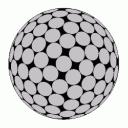Yahoo Answers is shutting down on May 4th, 2021 (Eastern Time) and beginning April 20th, 2021 (Eastern Time) the Yahoo Answers website will be in read-only mode. There will be no changes to other Yahoo properties or services, or your Yahoo account. You can find more information about the Yahoo Answers shutdown and how to download your data on this help page.
Trending News
Question about near-ring of 10 regular tetrahedra?
This is related to Duke´s question, here: http://answers.yahoo.com/question/index;_ylt=AssWm...
Ten regular tegrahedra are assembled to for a near-ring, as shown in this image: http://i39.tinypic.com/2eqcl88.png
The cosine of the gap angle, between the two planes that bound the gap, is a rational number.
(1) What is that rational number?
(2) Can each of the 10 regular tetrahedra be modified in the same way to give 10 congruent non-regular tetrahedra that fit together exactly to complete the "ring" ? If so what are the edge lengths of each of those non-regular tetrahedra? I.e. describe them exactly. Assume the original regular tetrahedra have edge length 1.
3 Answers
- FredLv 78 years agoFavorite Answer
Haven't worked out part (1) yet, but part (2) is fairly easy, given the picture I painted in my answer to Duke's question -- those 10 tetrahedra are 10 of the 20, sharing a common vertex at the center, that it would take to make the almost-closed icosahedron that can be folded into the 4th dimension to start the construction of a 600-cell regular polytope.
So then do this.
• take a regular icosahedron, edge length = 1, and hold it with one of its vertices directly upward
• connect each of its 12 vertices to the center, which will effectively slice the icosahedron into 20 congruent, almost-regular tetrahedra
• now remove the 5 tetrahedra that meet at that top vertex, and the 5 that meet at the bottom vertex
What you have left is the deca-ring you seek. Each tetrahedron has for its base, one of the equilateral, unit-side-length, equilateral triangular faces of the original icosahedron, with its other 3 edges equal to the circumradius, ₀R, of the icosahedron. ₀R will be slightly less than 1. It'll take me a little time to recall or recalculate that length . . .
EDIT:
Consulting Coxeter, the circumradius, ₀R, of the icosahedron, {p,q} = {3,5}, is
₀R = ½ sin(π/q) csc(π/h)
where h is given by
h = 2(p + q + 2)/(10 - p - q) = 10
₀R = ½ sin(π/5)/sin(π/10) = cos(π/10)
= ½√½(5+√5) = ½√(φ+2) = 0.9510565163...
where φ = ½(1+√5) = "Golden Ratio"
EDIT2:
Scythian has another elegant solution to part 2. His construction preserves the most edge-lengths of each tetrahedron (all but one!), while mine preserves more of their symmetries (i.e., each has 3-fold rotational symmetry about one altitude, with one equilateral and 3 congruent isosceles faces).
His, BTW, preserves a pair of mirror symmetries, in each of 2 planes, both passing through the center of the tetrahedron, one of them through the expanded edge, and the other perpendicular to it. The faces are, 2 congruent equilateral and 2 congruent isosceles.
These are surely just 2 of many ways to 'skin an icosahedron.'
-
Source(s): Regular Polytopes, 3rd ed., H. S. M. Coxeter, Dover Publications, 1973, p.21, eqn. 2•43; also, eqn. on p.15 - Scythian1950Lv 78 years ago
Please leave this one open a while longer.
Edit: I get the same answer as gianlino's, which is ArcCos(55205/59049) = 20.787758950....degrees.
As for possible non-regular tetrahedron, there's infinitely many solutions, one series which can be constructed by considering 2 parallel pentagons centered over each other spaced apart, but rotated. Then join the vertices. The non-regular tetrahedrons would have 3 edges that are equal, 2 more that are equal, and one oddball. Or, as a special case, 4 edges that are equal and 2 more that are equal. If you hold on, I'll get the graphic of this special case, which is related to the isocahedron, maybe the same as how Fred has described it.
Edit 2: Okay, a tetrahedron of 4 edges = 1 and 2 more = â((1/2)(5-â5)) = 1.1755705... will get the job done. Attach 2 caps from an isocahedron together at the common center vertex, and then join the remaining 10 edges to make 10 congruent irregular tetrahedrons. See graphic.
As a matter of fact, by rotating the caps a bit more, we can have tetrahedrons of 5 edges = 1, and just one oddball. Maybe I'll on that number too, but right now I'm taking an evening hike.
Back. Naw, won't work. Distance between the pentagrams is just over 1, if the 4 edges = 1. Well, it was worth a try. Okay, hold on this a bit longer, there's another way to do this.
Edit 3: Yes, 10 tetrahedrons of 5 edges = 1 and 1 edge = â((3/2)(3-â5)) = 1.0704662693... will combine to form a ring. See 2nd graphic. The oddball edge is the one that forms the top and bottom pentagons, all the rest are of equal length.
Edit 4: Yes, Fred, there's lots of ways to skin an isocahedron. Come to think about it, that should be another math problem, "how many distinct ways can an isocahedron be folded out flat?"
Edit 5: The answer to that one is 43,380 distinct unfoldings of an isocahedron. Well, I won't be posting that one.
Source(s): http://i254.photobucket.com/albums/hh120/Scythian1... http://i254.photobucket.com/albums/hh120/Scythian1... - gianlinoLv 78 years ago
(1) I got 55205 / 3^10 which is 0.934901.. and corresponds to x = 20.787759...




